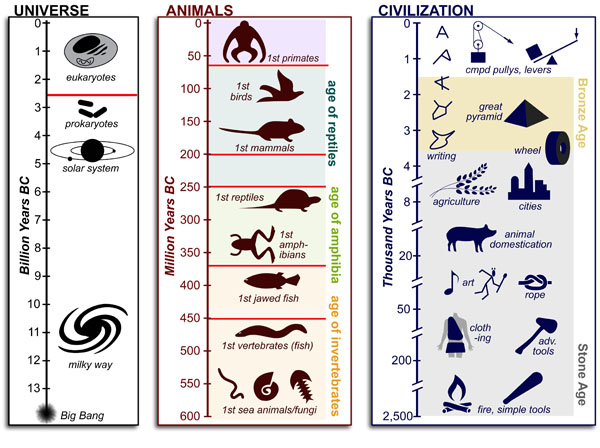Historical reference points make understanding evolutionary time a lot easier by “calibrating” it. In the figure above we provide three parallel timelines depicting key events in the history of the universe (billions of years), animal evolution (millions of years) and human development (thousands of years). Major extinction events are marked by horizontal red lines. Additional details can be found below.
UNIVERSE TIMELINE NOTES:
- 14.6 Billion years ago: the universe started with a Bang!
- 3.5 Billion years ago: simple life emerged in the form of prokaryotes and algae. Cyanobacteria produced oxygen as a by-produce of photosynthesis and began to transform the earth from an anerobic/reductive environment to an aerobic/oxidative one.
- 2.3 Billion years ago: oxygen accumulated to such an extant that it wiped out the majority of all life one Earth in the “Great Oxygenation Event”
- ~1.5 Billion years ago: complex life emerged in the form of eukaryotes which featured nuclei and organelles
ANIMAL EVOLUTION TIMELINE NOTES:
- 600 Million years ago: the diversity of life exploded in the “Cambrian Explosion” which produced the first animals and fungi. Several hypotheses exist for its cause including: sexual reproduction, and the formation of the ozone layer
- 600-420 Million years ago: sea invertebrates were the dominant form of life on earth
- 360-250 Million years ago: land amphibians were the dominant form of life on earth
- 250-85 Million years ago reptiles became the dominant form of life on earth after extinction events which caused the Earth to become drier and less hospitable to amphibians
- 85 Million years ago: mammals became the dominant form of life on earth following the Cretaceous-Paleogene extinction event which wiped out the dinosaurs
HUMAN CIVILIZATION TIMELINE NOTES:
- 2,500-200 thousand BC (lower Paleolithic): early humanoids diverged from chimpanzees. Fire and simple tools aided the evolution of the humanoid brain.
- 200-50 thousand BC (middle Paleolithic): modern humans (homo sapiens) emerge and begin to exhibit proto-modern behavioral patterns such as burying the dead, wearing clothing and making more complex tools.
- 50-20 thousand BC (upper Paleolithic): modern behavior patterns and abstract thinking emerge in the form of: language, group cooperation, religion, cave-art, music and new technologies such as rope. Dogs are the first domesticated species ~30,000BC.
- 20-8 thousand BC (Mesolithic): pigs, goats, sheep and cattle are domesticated.
- 8-3.5 thousand BC (Neolithic): humans transition from hunter-gather to civilization-based life with the spread of agriculture and cities. Cats are domesticated.
- 3.5-1.2 thousand BC (Bronze Age): writing is invented in Sumeria/Egypt initiating: (1) the beginning of history and (2) the development of complex technology. Over the next 3 thousand years writing evolved from a hieroglyphic-basis to an alphabetic-basis. Subsequent revolutionary intellectual/technological innovations include:
- ~3500 BC: the wheel
- ~2000 BC horses are domesticated
- ~500 BC: simple mechanical machines
- ~0: first analogue computers (e.g. slide-rule)
- ~1000 AD: gunpowder, explosives, compass
- ~1500 AD: printing press
- ~1800 AD: 1st batteries and capacitors
- ~1900 AD: light bulbs, radios, telephones
- ~1950 AD: nuclear power, transistor, digital computers, integrated circuits
- ~2000 AD: internet
REFERENCES:
- Big Bang 14.6 Billion years ago: Spergel, D.N.; et al. The Astrophysical Journal Supplement Series, 2003 148, 175-194
- Big Bang 14.6 Billion years ago: Bond, H.E.; et al. The Astrophysical Journal, 765, L12.
- Big Bang 14.6 Billion years ago: Ade, P.A.R.; et al. Astronomy and Astrophysics, 2014, 571, A16.
- Milky Way 11 Billion years ago: Krauss, L.M.; Chaboyer, B. Science, 2003, 299, 65-69.
- Solar System 4.6 Billion years ago: Bouvier, A.; Wadhwa, M. Nature Geocience, 2010, 3, 637-641.
- Early Life 3.5 Billion years ago: Schopf, J.W. Phil. Trans. R. Soc. B 2006, 361, 869-885.
- Cambrian Explosion 600 Million years ago Kerr, R. Science, 1995, 267, 33-34.
- Animal Evolution Overview: Sahney, S.; Benton, M.J.; Ferry, P.A. Biol. Lett. 2010, 6, 544-547.
- Earth Extinction Events Overview: Alroy, J. PNAS, 2008, 105, 11536-11542.
- Vertebrates 500 million years ago: Baker, C.V.H., Curr. Op. Gen. Dev. 2008, 18, 536-543.
- Jawed Fish/Adaptive-immunity 400 Million years ago: Cooper, M.D.; Alder, M.N. Cell 2006, 124, 815-822.
- Amphibians 350 Million years ago: San-Mauro, D. et al. The American Naturalist, 2005, 165, 590-599.
- Amphibians 350 Million years ago: San-Mauro, D. et al. Mol. Phylo. Evol., 2010, 56, 554-561.
- Fire 2 million years ago: Organ, C. et al. PNAS, 2011, 108, 14555-14559.
- Fire 2 million years ago: James, S.R. Curr. Anthropol. , 1989, 30, 1-26.
- Clothing 170 thousand years ago: Toups, M.A.; et al. Mol. Biol. Evol., 2011, 28, 29-32.
- Fire-treated tools 164 thousand years ago: Brown, K.S.; et al. Science, 325, 2009, 859-862.
- Burial/Religion 100 thousand years ago: Garget, R.H. J. Hum. Evol., 1999, 37, 27-90.
- Flutes 30 thousand years ago: Conrad, N.j.; Malina, M.; Munzel, S.C. Nature, 2009, 460, 737-740.
- Dogs 30 thousand years ago: Thalmann, O.; et al. Science, 2013, 342, 871-874.
- Rope 28 thousand years ago: Small, M.F. Natural History (At the Museum), 4, 14.
- Civilization Overview: Anthony, D. The horse, the Wheel and Language 2007 Princeton University Press.

This work by Eugene Douglass and Chad Miller is licensed under a Creative Commons Attribution-NonCommercial-ShareAlike 3.0 Unported License.


Pingback: Don’t Know Much about a Science Book . . . « Armchair Naturalist